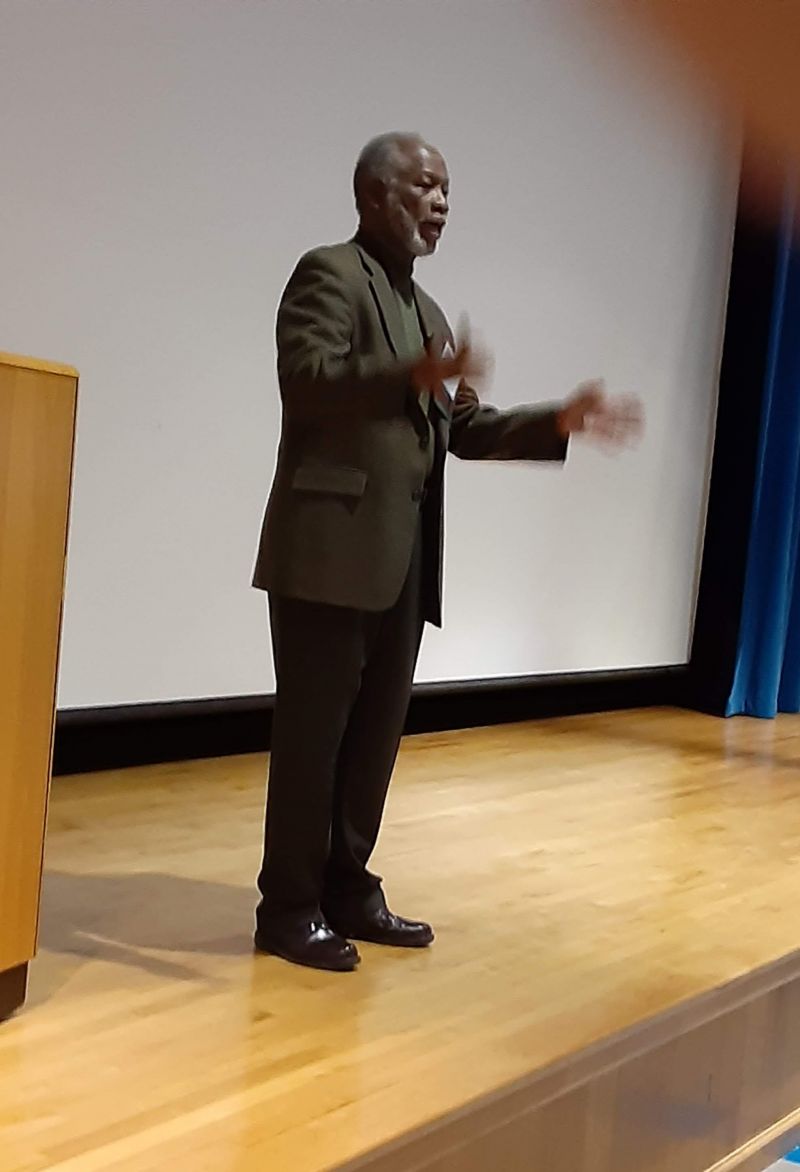
“Coffee with Cops” at Saturday’s race summit gave citizens the chance to chat with local law enforcement officers such as (L-R) Patrick Woodrum, George Lee and Nathan Joiner of the Montgomery County Sheriff’s Office. Officers from the Christiansburg and Blacksburg police departments also took part.Between 1965 and 2005, the African-American community in the United States lost a staggering $2.3 trillion to income discrimination in the difference paid between white and black employees.
On the heels of that disheartening statistic, a more encouraging sign is that in the New River Valley today, when workers are employed full time, there is not enough difference in the median income to complain about, both males and females and blacks and whites.
These were just two of the interesting facts revealed by Dr. Wornie Reed Saturday. He was the keynote speaker for the 2020 winter summit of the Dialogue on Race at Christiansburg Middle School.
“So if blacks get a full-time job, they receive incomes similar to whites in the New River Valley,” Reed said. “The problem is there are fewer jobs [for blacks here]. So much of the income inequality in the New River Valley results from lower employment, not lower income.”
Reed, professor of sociology and Africana studies and the director of the Race and Social Policy Research Center at Virginia Tech, presented the summit’s keynote address, titled “The Continuing Cost of Employment Discrimination.” Backed by a slide presentation, the professor used a mass of statistics and facts that laid out just how real, pervasive and ongoing are the employment and income gaps between the genders and the races in America.
The Dialogue on Race arose from a series of four focus group-type meetings between October 2011 and April 2011 at which a group of 22-25 African Americans gathered. In dialogues coordinated by the DOR’s steering committee and facilitated by Dr. Reed, the participants developed a list of six racial issues faced by blacks in Montgomery County.
Those six issues are law enforcement, education, jobs and employment, income gap, white privilege and Jim Crow orientations, and the limited presence of African Americans on boards and commissions. These six issues have thus formed the basis for the larger community’s dialogue, the Dialogue on Race.
The mission of the Dialogue on Race is to create a forum that examines racial issues articulated by the African-American community in Montgomery County and then develops and implements solutions for those issues.
Saturday’s session began with Coffee with Cops, a gathering of local citizens and local law enforcement personnel to talk and air grievances. Officers from the Montgomery County Sheriff’s Office, the Christiansburg Police Department and the Blacksburg Police Department took part in the sit-down sessions that preceded the formal summit program.
Relying on countless statistical information garnered in the post-civil rights era from 1967-2005, Dr. Reed presented stark facts that reveal the existence of discrimination in the American job market. For instance, for African-American men in 1967, the median income for those employed full time was about $26,000. For white men, the median income was some $45,000. In 2005, the latest year comparative figures are available, the income figure was black men was +-$33,000; for white males the income level was $51,270. In other words, the gap has not narrowed in all that time. For African-American females in 2005, the median income was $26,300 while it was +-$28,000 for white females.
Dr. Reed agreed that education is one of the explanations for the disparity, but he revealed statistics that show that a college degree does not narrow the income gap between black and white employees.
With education levels not taken into account, the income gap widened between 1967 and 2005.
“Even adjusted for education,” Dr. Reed said, “blacks still make less than whites” at all points from 1967-2005. This applies to both men and women.
“There is a cost to this job discrimination,” the professor told his audience. “How much money has been lost in the African-American community because of this discrimination?” He then showed the staggering statistic that from 1967-2005, the loss to black Americans as compared to the salaries paid to white Americans with comparable education levels was $2.3 trillion.
“And things are getting better, not worse,” Dr. Reed said.
Turning to the Commonwealth of Virginia, Dr. Reed used figures provided to the federal government by more than 3,000 private employees who responded to a survey in 1999. The government agency found that 48 percent of all those reporting discriminated against African-Americans in what they were paid. In other words, the gap between blacks and whites and/or men and women was large enough and common enough that the companies could be assumed to be discriminating. Some 31,862 African-American employees were affected.

This didn’t take into account the businesses who did not bother to take part in the survey. “If you’re guilty of discrimination but can’t provide data, then you’re only making the program worse, not better,” Dr. Reed said.
Finally, Dr. Reed presented statistics for Montgomery County from 2011-2015. The income gap was even wider in the New River Valley than at the state and national levels. The mean income of African-Americans here during that period was +-$22,000. For whites, it was +-$36,000.
“A lot of that difference has to do with the fact that the unemployment rate in this area among blacks is higher than it is among whites,” Dr. Reed explained (4.66 percent for whites in the area vs. 15.72 percent for blacks).
The good news, however, is that the disparity doesn’t apply when workers are employed full time in the NRV. In that case, Dr. Reed said, there is not enough difference in the median income to complain about, both males and females and blacks and whites.
“So if blacks get a full-time job, they receive incomes similar to whites in the New River Valley,” Reed said. “The problem is there are fewer jobs [for blacks here]. So much of the income inequality in the New River Valley results from lower employment, not lower income.”

